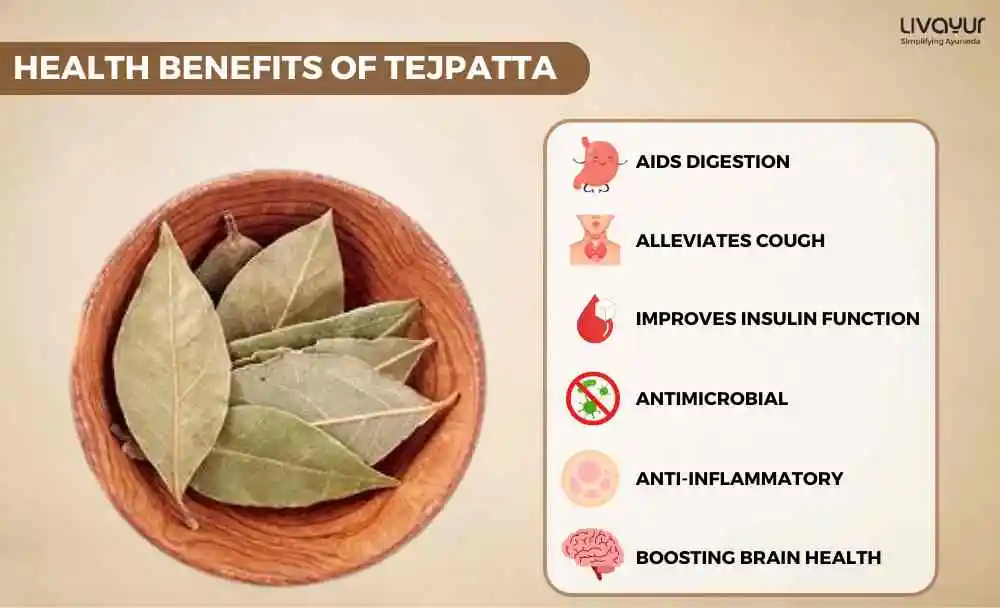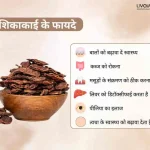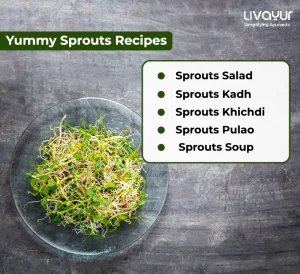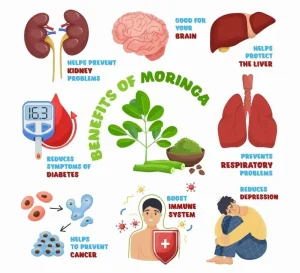
Tejpatta, also called the Indian bay leaf, is an aromatic leaf derived from the evergreen Cinnamomum tamala tree native to India. The leaves are dried and used whole or powdered as a popular seasoning ingredient in Indian cuisine, valued for imparting a mildly sweet and clove-like flavour to dishes along with a hint of fragrance. Below, we’ll discuss these modest leaves and what makes them special.
The nutritional value of Tejpatta
Tejpatta has a nutritional profile that supports metabolic functions (2) and boosts immunity.
| Nutrient | Amount per 1 tsp (0.6 g) |
| Vitamin A | 1.850 mcg |
| Vitamin B1 | 0.000 mcg |
| Vitamin B2 | 0.003 mg |
| Vitamin B3 | 0.012 mg |
| Vitamin B6 | 0.010 mg |
| Vitamin B9 | 1.080 mcg |
| Vitamin B12 | 0.000 mcg |
| Vitamin C | 0.300 mg |
| Vitamin D | 0.000 mcg |
| Selenium | 0.02 mcg |
| Calcium | 5.000 mg |
| Iron | 0.300 mg |
| Sodium | 0.100 mg |
| Potassium | 3.2 mg |
| Magnesium | 0.72 mg |
| Ash | 0.1 g |
| Manganese | 0.049 mg |
| Phosphorus | 0.68 mg |
| Water | 0.1 g |
Other Names and Types of Tejpatta
Some English names of Tejpatta are:
- Malabar leaf
- Indian bark
- Indian cassia
- Malabathrum
It is also known by various names in the vernacular languages of India like
- Patraka in Kannada
- Tejpatta (mainly pertaining to the dried leaves) in Hindi
- Tezpat in Urdu
- Tamalapatram in Malayalam
How to Use Tejpatta
The tej patta medicinal uses are as follows:
- Add a whole Tejpatta to your soups, stews, and broths early in the cooking process.
- Place one or two leaves with your rice as it cooks to infuse a subtle aroma.
- Brew a soothing tea with dried Tejpatta to enjoy its health benefits, including improved digestion and respiratory relief.
- Use a decoction of Tejpatta as a skin toner or to rinse hair.
Health Benefits of Tejpatta
Rich in antioxidants and essential oils, Tejpatta offers numerous health benefits, from improving digestion to enhancing heart health. It’s a traditional remedy for colds and influenza, used in culinary and medicinal forms. Here are these health benefits of Tejpatta:
1. Boosting Brain Health
Compounds in Tejpatta, such as cineole and linalool, are thought to enhance cognitive functions, potentially aiding in the management of stress and anxiety. It also improves alertness and alleviates symptoms of fatigue.
2. For Skin and Hair
Tejpatta’s antimicrobial and anti-inflammatory properties (3) help treat skin infections and promote hair health. It’s often used in decoctions to rinse hair to add shine and address dandruff issues.
3. Managing Diabetes with Tejpatta
Tejpatta has been shown to help regulate blood sugar levels (1), making it a beneficial addition to diabetics’ diet. It improves insulin function, which is essential for sugar metabolism.
4. Respiratory Relief
The essential oils in Tejpatta have expectorant properties, making it useful in treating respiratory conditions such as bronchitis and sinusitis. A hot tea made with bay leaves can alleviate cough and aid in loosening phlegm.
5. Cholesterol Management
Regular consumption of Tejpatta has been linked to improved cholesterol levels. Its compounds help reduce bad LDL cholesterol while boosting good HDL cholesterol.
6. Healing Wounds with Tejpatta
Tejpatta’s antimicrobial properties help prevent infection and speed up the healing of wounds when applied in paste form or used in bathing water.
7. Soothing Stomach Complaints
Tejpatta is beneficial for digestion and helps treat issues like heartburn, bloating, and flatulence. Its digestive enzymes aid in breaking down complex proteins and rich foods, making digestion smoother.
Precautions to take with Tejpatta
- Use sparingly. Tejpatta has an assertive flavour, so you only need a couple of leaves in a dish.
- Remove before serving. Tejpatta is not meant to be eaten. The leaves are taken out of a dish before eating, as accidentally eating them can result in the leaf getting stuck in your throat.
- Monitor cooking time. The flavor of tejpatta intensifies the longer it cooks. For milder flavor, add tejpatta towards the end of cooking.
- Store properly. Tejpatta leaves are delicate and can lose flavor over time. Store in an airtight container away from sunlight to preserve freshness.
- Use whole leaves. Crushing or tearing leaves before cooking will strengthen the bay leaf flavor. Use whole leaves instead for more control over the flavor.
Side Effects
No toxic side effects or risky reactions have been linked with tejpatta consumption at doses used for culinary or therapeutic purposes per extant documentation. Still keeping leaves fresh and pathogen-free while limiting intake prevents unlikely nausea.
Drug Interaction Effects
The anticoagulant nature and blood glucose regulation require dosage adjustments for patients on respective medications, requiring medical guidance to optimise combinations to achieve additive benefits sans side effects. Immune boosting by tejpatta also bears considerable synergistic potential (both positive and negative) with antibiotic regimens, depending on their pharmacokinetics.
Conclusion
Tejpatta, with its distinctive aroma and rich nutritional profile, serves as both a culinary delight and a medicinal boon. Whether it’s enhancing the flavors of various dishes or offering health benefits like improved digestion and cholesterol management, Tejpatta is a versatile herb. Its uses extend from the kitchen to natural remedies, underscoring its importance in traditional and modern practices alike.
FAQs
What is the difference between Tejpatta and Bay Leaves?
Tejpatta and Bay Leaves arise from different tree species – with Tejpatta derived uniquely from the Cinnamomum tamala plant. Accordingly, they exhibit distinct aroma profiles, taste tones, and phytochemical constituents responsible for respective therapeutic outcomes and cuisine applications.
What is the use of Tejpatta?
Tejpatta serves dual roles: Culinarily enhancing the flavor/fragrance of food while being a healthy metabolism & digestion aid. Medicinally, it alleviates lung issues, blood sugar spikes, and liver toxicity and promotes immunity plus healing – thanks to antioxidants and bioactive chemicals.
How is the Tejpatta tree grown?
Tejpatta trees flourish in humid subtropical climates with significant rainfall and moist soil. Propagation happens quickly from seeds and cuttings. Leaves get harvested after nearly a decade once trees mature adequately for optimal phytochemical levels suiting usage.
What are the side effects of consuming Tejpatta?
No noticeable side effects or toxicity occur with dietary or therapeutic tejpatta consumption. Still, moderation remains key while drying leaves adequately to avoid spoilage issues that cause unlikely but occasional nausea.
Which part of Tejpatta is used?
Dried whole, intact leaves or tejpatta leaf powder find primary usage in cuisine, supplements, plus traditional medicine for harnessing aroma, nutrition and therapeutic benefits through years of documented human usage globally.
Reference
1. Tejpatta has been shown to help regulate blood sugar levels (researchgate.net)
2. Tejpatta has a nutritional profile that supports metabolic functions (researchgate.net)
3. Tejpatta’s antimicrobial and anti-inflammatory properties (researchgate.net)














